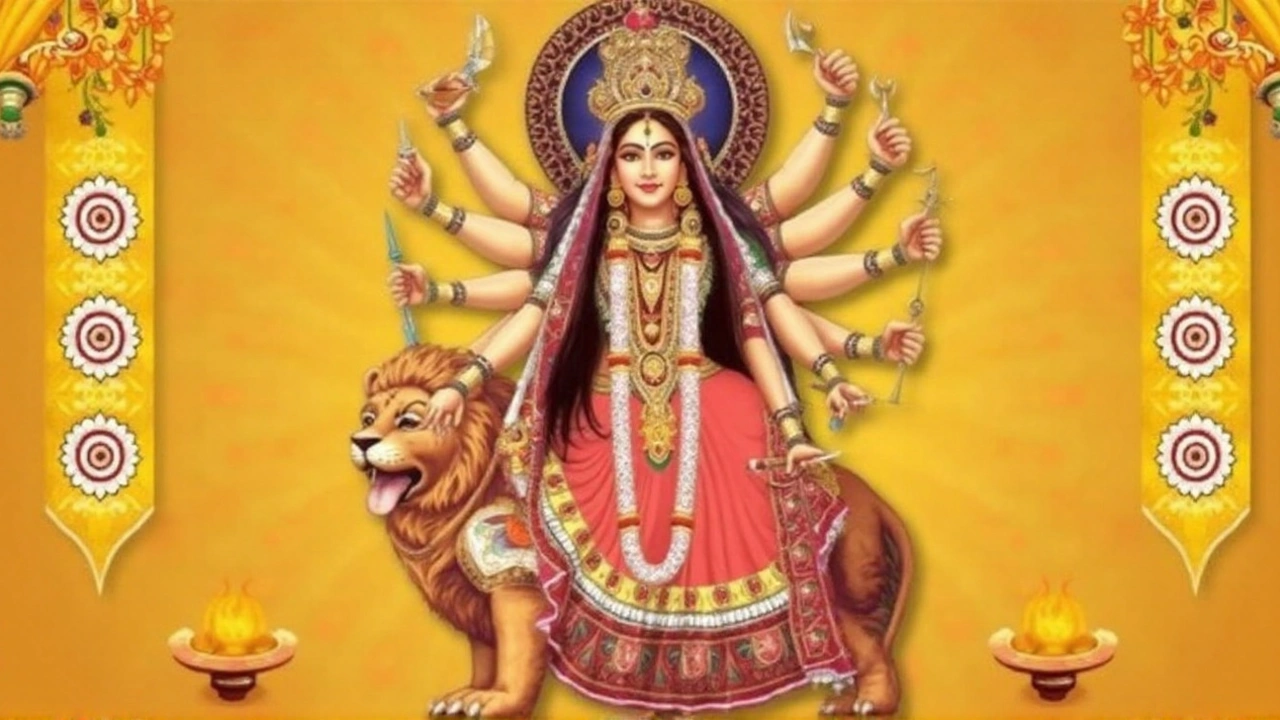Daily Color Guide for Navratri 2022
Navratri, celebrated twice a year during the Sharada (Sept‑Oct) and Chaitra (Mar‑Apr) seasons, revolves around nine divine forms of Goddess Durga. Each form carries a distinct vibe, and devotees match that vibe with a particular color. The practice isn’t just about looking good; it’s a way to sync your personal energy with the cosmic rhythm of the day.
Day 1 – White for Goddess Shailputri. White stands for purity, new beginnings, and inner calm. When you dress in white on the first night, you’re inviting a fresh start and a clear mind. Many families start the festival with a simple white kurta or sari, often paired with a pearl necklace that symbolizes the untouched spirit of the mountain maiden.
Day 2 calls for red, the hue of Goddess Brahmacharini. Red fuels passion, courage, and vitality. Traditional red chunris (sacred scarves) are presented to the deity, and women often wear red lehengas or bandhgalas to embody the fierce determination of the ascetic goddess.
On Day 3 you’ll see royal blue for Goddess Chandraghanta. This deep, regal shade reflects divine stability and the power to overcome darkness. Royal blue silk sarees or kurtas are popular, and the color is said to help meditative focus during the night’s prayers.
Day 4 shifts to sunny yellow, honoring Goddess Kushmanda, the creator of the universe with her smile. Yellow brings joy, optimism, and intellectual sparkle. Many homes decorate the altar with marigold garlands, and devotees wear yellow cottons or chiffon that echo the goddess’s radiant energy.
Day 5 welcomes green for Goddess Skandamata, the mother of Lord Kartikeya. Green symbolizes growth, fertility, and balance. Green Banarasi silk or simple cotton shirts are common, and the shade is believed to nurture personal relationships and financial stability.
Grey takes the stage on Day 6 for Goddess Katyayani. Though understated, grey conveys strength, neutrality, and refined poise. A grey kurta or saree can help the wearer stay grounded while navigating life’s complexities, mirroring the goddess’s composed demeanor.
Day 7 lights up with orange for Goddess Kalaratri, the fierce protector who banishes evil. Orange radiates enthusiasm, warmth, and spiritual awakening. Traditional orange turbans or dupattas are favored, channeling the goddess’s fiery resolve.
Day 8 dazzles with peacock green for Goddess Mahagauri. This vibrant, iridescent shade captures beauty, grace, and divine elegance. Many opt for peacock‑green silk dresses, and the color is thought to bring wisdom and inner peace.
Finally, Day 9 showcases pink for Goddess Siddhidatri, the granter of supernatural powers. Pink embodies love, kindness, and playful joy. A pink chiffon saree or light scarf is often chosen to celebrate the culmination of the nine‑day journey and to seal wishes for the coming year.
Why the Colors Matter: Tradition, Psychology, and Community
The practice of wearing specific hues dates back to ancient Vedic texts that linked color frequencies with emotional and spiritual states. Modern color psychology supports many of these claims: white calms, red energizes, blue stabilizes, yellow uplifts, green heals, grey balances, orange stimulates, green‑blue (peacock) inspires creativity, and pink nurtures affection.
Beyond the individual, the collective visual spectacle is a hallmark of Navratri’s communal events. In Gujarat, the streets of Ahmedabad become a moving rainbow as families parade through Garba venues, each cluster of dancers clothed in the day’s color. The visual harmony reinforces a sense of unity—everyone, regardless of socioeconomic status, participates in the same chromatic rhythm.
For diaspora communities, the color tradition serves as a cultural bridge. In New York’s Queens borough, local temples organize Navratri nights where volunteers hand out color‑coded wristbands. Immigrants wear the prescribed shades, forging a link to their heritage while sharing the experience with curious neighbors.
There’s also a practical side. By planning outfits in advance, families reduce last‑minute shopping stress and promote sustainable fashion choices. Many artisans now create multi‑day kits—matching dupattas, scarves, and jewelry—so devotees can swap pieces without buying new garments each day.
Health enthusiasts note that aligning daily attire with color can influence mood and even physiological responses. A brief study conducted by the University of Pune measured heart‑rate variability among participants who wore traditional Navratri colors versus neutral tones. The color‑aligned group showed increased parasympathetic activity, indicating reduced stress during the festival’s high‑energy dances.
From a spiritual angle, each color acts as a mantra of its own. When a devotee dresses in the prescribed hue, they silently affirm the virtues of the day’s goddess—purity for Shailputri, passion for Brahmacharini, and so on. This silent affirmation deepens the meditation that accompanies the nightly aarti (ritual fire).
Even the foods served reflect the day’s palette. White rice dishes on Day 1, red‑spiced dal on Day 2, blue‑tinted sweets made with butterfly pea flower on Day 3, turmeric‑golden curries on Day 4, leafy greens on Day 5, neutral gram flour snacks on Day 6, orange‑carrot halwa on Day 7, peacock‑green pistachio desserts on Day 8, and pink rose‑flavored sherbet on Day 9 create a full‑sensory celebration.
For modern dressers, the tradition can be adapted without breaking cultural norms. A simple white kurta paired with a navy blazer for Day 1 feels both traditional and office‑appropriate. On Day 3, a royal‑blue tie or scarf can convey the hue’s energy without a full costume. The key is intention—wear the color as a reminder of the goddess’s qualities you wish to embody.
In sum, the nine colors of Navratri are more than decorative choices; they are a living language of devotion. By integrating them into clothing, food, and community rituals, devotees turn a nine‑night festival into a full‑body experience that aligns heart, mind, and spirit with the divine feminine.
